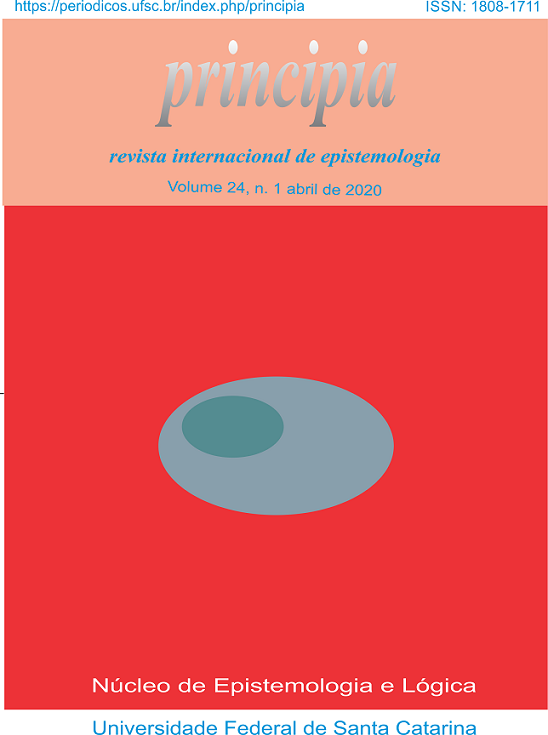What makes a possible world physycally possible?
DOI:
https://doi.org/10.5007/1808-1711.2020v24n1p65Abstract
There is a widely extended viewpoint about physical possibility, what we will call Standard Approach, which holds that the physically possible is delimited by the nomological structure of physical theories: to be physically possible is to be in accordance with the physical laws, to be physically impossible is to be prohibited by physical laws and to be physically necessary is to be demanded by the physical laws. However, it is possible to show that this approach is too relaxed and permissive when it comes to collecting and systematizing many of the modal intuitions present in the physical community. In this work we will argue, on the one hand, that the notion of physical possibility is more complex and richer than suggested by the standard approach and, on the other hand, that it is necessary to add some extra elements to the characterization of physical possibility in order to that it is adequate in scientific contexts.
References
Armstrong, D. 1978. A Theory of Universals. Cambridge: Cambridge University Press.
Armstrong, D. 1983. What Is a Law of Nature? Cambridge: Cambridge University Press.
Belot, G. 2011. Geometric Possibility. Oxford: Oxford University Press.
Bradley, R. y Swartz, N. 1979. Possible Worlds: An Introduction to Logic and its Philosophy. Indianapolis: Hackett Publishing Company.
Carroll, J. 2012. Laws of nature, in E. N. Zalta (ed.), The Stanford Encyclopedia of Philosophy.
Cartwright, N. 1983. How the laws of physics lie. New York: Oxford University Press.
Chalmers, D. y Jackson, F. 2001. Conceptual Analysis and Reductive Explanation. Philosophical Review 110: 315–61.
Cohen, J. y Callender, C. 2009. A better best system account of lawhood. Philosophical Studies 145: 1–34.
Earman, J. 1989. A Primer on Determinism. Dordrecht: Kluwer.
Ellis, B. 2001. Scientific Essentialism. Cambridge: Cambridge University Press.
Fine, K. 1994. Essence and Modality. Philosophical Perspectives 8: 1–16.
Godel, K. 1949. An example of a new type of cosmological solution of Einstein`s field equations of gravitation. Review of Modern Physics 21: 447 – 450.
Hall, A. 1985 [1954]. La Revolución Científica. 1500 – 1750. Barcelona: Editorial Crítica.
Hawkin, S. 2011 [1988]. Historia del Tiempo. Del Big – Bang a los Agujeros Negros. Madrid: Alianza Editorial.
Humberstone, L. 2015. Philosophical Applications of Modal Logic. London: College Publications.
Jubien, M. 1996. Actualism and iterated modalities. Philosophical Studies 84: 109–125. 2009.
Kment, B. 2017. Varieties of Modality in The Stanford Encyclopedia of Philosophy (Edward N. Zalta ed.), URL = https://plato.stanford.edu/archives/spr2017/entries/modality-varieties/.
Koyré, A. 1965. Newtonian Studies. London: Chapman and Hall.
Kripke, S. 1959. A completeness theorem in modal logic. Journal of Symbolic Logic 24: 1–15.
Kripke, S. 1963. Semantical Considerations on Modal Logic. Acta Philosophica Fennica 16: 83–94.
Kripke, S. 1980. Naming and Necessity. Cambridge, Massachusetts: Harvard.
Lange, M. 2007. Laws and meta-laws of nature: Conservation laws and symmetries. Studies in History and Philosophy of Modern Physics 38: 457–481.
Lewis, D. 1973. Counterfactuals. Cambridge: Harvard University Press.
Lewis, D. 1986. On The Plurality of Worlds. Oxford: Blackwell.
Loewer, B. 1996. Humean Supervenience. Philosophical Topics 24: 101–126.
Maudlin, T. 2007. The Metaphysics Within Physics. New York: Oxford University Press.
Morris, M., Thorne, K., Yurtsever, U. 1988. Wormholes, Time Machines, and the Weak Energy Condition. Physical Review Letters 61: 1446 – 1449.
Mumford, S. 2004. Laws in Nature. London: Routledge.
Newton, I., Cohen, B., Whitman, A. 1999. The Principia: Mathematical Principles of Natural Philosophy. Berkeley, California: University of California Press.
Plantinga, A. 1974. The Nature of Necessity. Oxford: Oxford University Press.
Priest, G. 2008. An Introduction to Non-classical Logic. Cambridge: Cambridge University Press.
Putnam, H. 1975. The Meaning of Meaning. Minnesota: Minnesota Studies in the Philosophy of Science 7: 131-193.
Ruetsche, L. 2013. Interpreting Quantum Theories. Oxford: Oxford University Press.
Soames, S. 2005. Reference and Description: The Case against Two-Dimensionalism. Princeton: Princeton University Press.
Soames, S. 2011. Kripke on Epistemic and Metaphysical Possibility: Two Routes to the Necessary A posteriori, in Saul Kripke, A. Berger (ed.). New York: Cambridge University Press.
Torii, T. y Shinkai, H. 2013. Wormholes in higher dimensional space-time: Exact solutions and their linear stability analysis. Physical Review D 88: 064027.
Uffink, J. 2001. Bluff your way in the second law of thermodynamics. Studies in the History and Philosophy of Modern Physics 32: 305–394.
Van Inwagen, P. 1986. Two concepts of possible worlds. Midwest Studies in Philosophy XI: 185-213.
Downloads
Published
Issue
Section
License

Principia http://www.periodicos.ufsc.br/index.php/principia/index is licenced under a Creative Commons - Atribuição-Uso Não-Comercial-Não a obras derivadas 3.0 Unported.
Base available in www.periodicos.ufsc.br.



